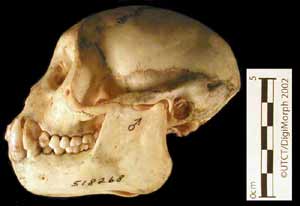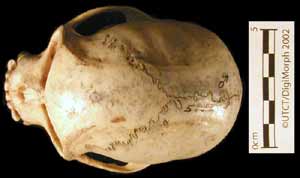 All-new movies and applet added October 2012! All-new movies and applet added October 2012!
Cebus apella, the tufted capuchin, is a South American or New World monkey. South American monkeys or platyrrhines comprise one of the two infraorders (Platyrrhini and Catarrhini) of anthropoid primates. They live exclusively in South and Central America, but their fossil distribution includes the Greater Antilles (MacPhee and Horovitz, 2002). The fossil record of platyrrhines extends back to the Deseadan or late Oligocene of Bolivia where they are represented by the genus Branisella (Takai and Anaya, 1996). Their presence in the New World is generally considered to be the result of a single dispersal event (Fleagle, 1999) near the end of the Eocene from the Old World, where all known basal anthropoids are found (Beard, 2002). Because South America was not connected with North America or Africa at the time, this dispersal must have involved rafting across some portion of the Atlantic. |
|
Once in the New World, platyrrhines diverged into a variety of forms ranging in size from the smallest living anthropoid (Cebuella) at ~110 grams to the howler monkeys (Alouatta) that reach 11 kg (Fleagle, 1999). This diverse radiation of primates includes 78 living species (Fleagle, 1999) in 16 genera, one of which is the only living nocturnal anthropoid, Aotus. Their diets and locomotor adaptations are diverse, though most are at least partly frugivorous and none are primarily terrestrial.
Although the adaptations of different genera are reflected in their craniodental anatomy, platyrrhines in general retain a cranial morphology more similar to primitive anthropoids from the Eocene and Oligocene of Egypt such as Catopithecus, Parapithecus, and Aegyptopithecus than do the living Old World anthropoids (Fleagle, 1999; Simons, 2001). The research for which these CT data were collected indicates that this primitive anthropoid cranial morphology included considerable cranial pneumatization via the paranasal sinuses. |
|
Cebus apella is largely frugivorous and feeds on hard palm nuts. They are among the more sexually dimorphic of platyrrhines, with average body weights of 3,650g for males and 2,520g for females (Fleagle, 1999). Cebus is a close relative of Saimiri, both of which appear to be more closely related to marmosets and tamarins than to atelines and pitheciines (Schneider et al., 1996; Horovitz, 1999).

About the Species
This male specimen, the skull of an adult (all teeth in place), was collected in Brazil on 30 July 1947. It was made available to The University of Texas High-Resolution X-ray CT Facility for scanning by Dr. James Rossie of Stony Brook University , courtesy of the Smithsonian Institution Division of Mammals. Scanning was funded by an NSF dissertation improvement grant to Mr. Rossie (#0100825). Funding for image processing was provided by a National Science Foundation Digital Libraries Initiative grant to Dr. Timothy Rowe of The University of Texas at Austin.
 |
lateral view |

 |
dorsal view |

About this Specimen
This specimen was scanned by Matthew Colbert on 14 July 2002 along the coronal axis for a total of 481 slices. Each slice is 0.18796 mm thick, with an interslice spacing of 0.18796 mm and a field of reconstruction of 80.0 mm.

About the
Scan
Literature
Beard, K. C. 2002. Basal anthropoids. In (W. C. Hartwig, Ed) The Primate Fossil Record, pp. 133-149. Cambridge, Cambridge University Press.
Fleagle, J. G. 1999. Primate Adaptation and Evolution. San Diego, Academic Press.
Horovitz, I. 1999. A phylogenetic study of living and fossil platyrrhines. American Museum Novitates 3269:1-40.
MacPhee, R. D. E. and I. Horovitz. 2002. Extinct Quaternary platyrrhines of the Greater Antilles and Brazil. In (W. C. Hartwig, Ed) The Primate Fossil Record, pp. 189-200. Cambridge, Cambridge University Press.
Schneider, H., I. Sampaio, M. L. Harada, C. M. L. Barroso, M. P. C. Schneider, J. Czelusniak and M. Goodman. 1996. Molecular phylogeny of the New World monkeys (Platyrrhini, Primates) based on two unlinked nuclear genes: IRBP intron 1 and epsilon-globin sequences. American Journal of Physical Anthropology 100:153-179.
Simons, E. L. 2001. The cranium of Parapithecus grangeri, an Egyptian Oligocene anthropoidean primate. Proceedings of the National Academy of Sciences, USA 98:7892-7897.
Takai, M. and F. Anaya. 1996. New specimens of the oldest fossil platyrrhine, Branisella boliviana, from Salla, Bolivia. American Journal of Physical Anthropology 99:301-317.
Links
Cebus apella on the Animal Diversity Web (University of Michigan)
Cebus apella on the Primate Info Net (University of Wisconsin, Madison)

Literature
& Links
None available.

Additional
Imagery
|

